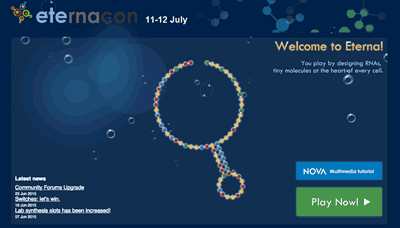
Homepage of the eteRNA website.

Homepage of the eteRNA website.
Ribonucleic acid — or RNA — is key to life, playing a role in regulating the functions of cells. Scientists have been exploring RNA structures to better understand their biological roles.
To that end, researchers at Carnegie Mellon University and Stanford University have harnessed the power of crowdsourcing to create new RNA designs through an online game. Funded through seed grants from by the National Institutes of Health, the National Science Foundation, Stanford University and others, EteRNA is a browser-based “game with a purpose” that lets players solve puzzles related to the folding of RNA molecules. The goal is to help find RNA molecules that are biologically active.
Download this case study (PDF, 46KB)
Website: EteRNA
EteRNA is a two-dimensional puzzle-solving exercise using the four bases — adenine, guanine, uracil and cytosine — that make up RNA molecules. Players can design elaborate structures, including knots, lattices and switches.
EteRNA takes advantage of human problem-solving capabilities to solve puzzles that are too difficult for computers, given their lack of human intuition. As one project developer put it, “Computers don’t have flashes of insight.” The researchers are capitalizing on the collective intelligence of EteRNA players to answer fundamental questions about RNA folding mechanics.
Each week, the gaming community chooses the best designs created by players. Scientists at Stanford then synthesize the selected RNA molecules to see how their folding patterns compare with computer predictions, thereby improving computer models.
The game is based on Foldit, so the developers did not face the challenges of starting from scratch.
EteRNA’s creators have been pleasantly surprised by the solutions of EteRNA players: Because not all of the players are experts in the field of RNA research, their creativity isn’t constrained by what they think a correct answer should look like. Tens of thousands of players have contributed RNA sequence designs, with hundreds of designs synthesized for testing so far.
Ultimately, EteRNA researchers hope to identify a complete and repeatable set of rules for synthesizing RNA molecules that consistently fold in expected shapes. Such basic principles would facilitate the design of RNA-based nanomachines and switches. As one researcher put it, the dream is to create a functional RNA that can be transcribed into cells to sense light or even deactivate a virus.
By operating as a “massive open laboratory,” the EteRNA researchers have engaged about 37,000 non-experts in scientific research in a creative, meaningful and productive way. Their efforts have led to not only the identification of RNA design rules but also the development and improvement of automated algorithms for predicting RNA structures. Results show that lay participants in a massive open laboratory can generate hypotheses and conduct experiments. This project is ongoing; lab results are shared publicly on the EteRNA website on a regular basis.
The EteRNA case study illustrates the following steps in the Federal Citizen Science and Crowdsourcing Toolkit:
Peter Preusch
Email: preuschp@nigms.nih.gov